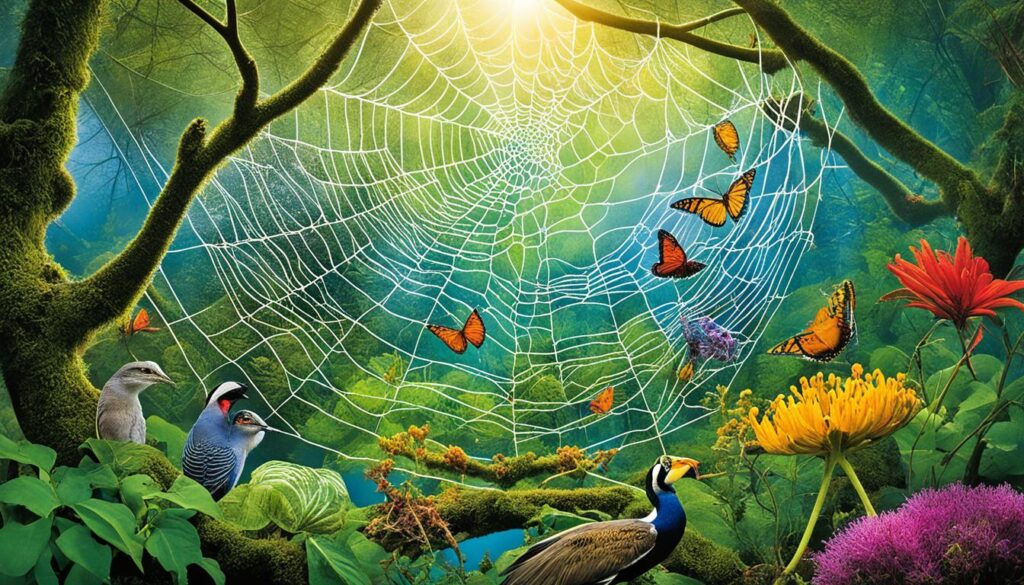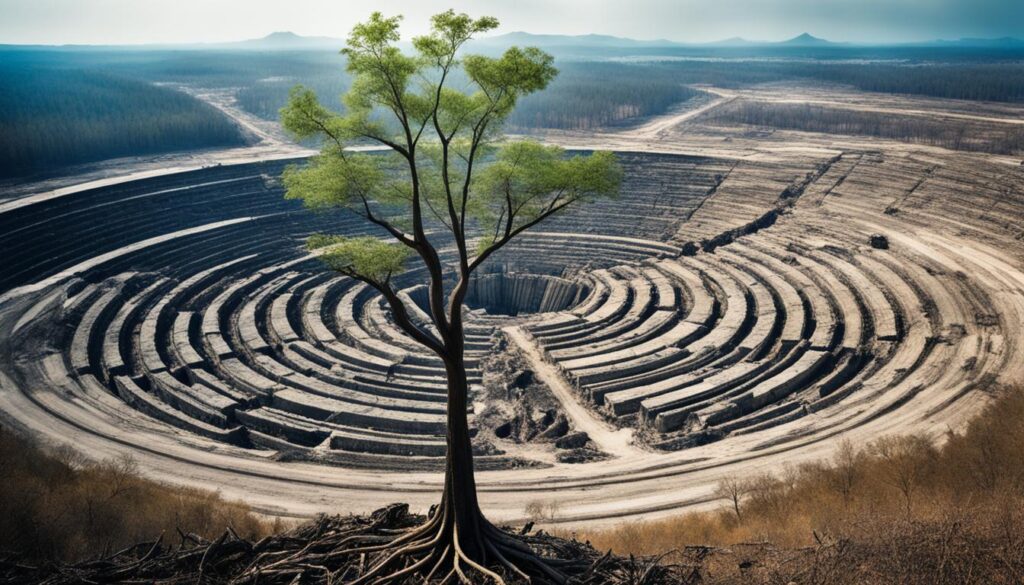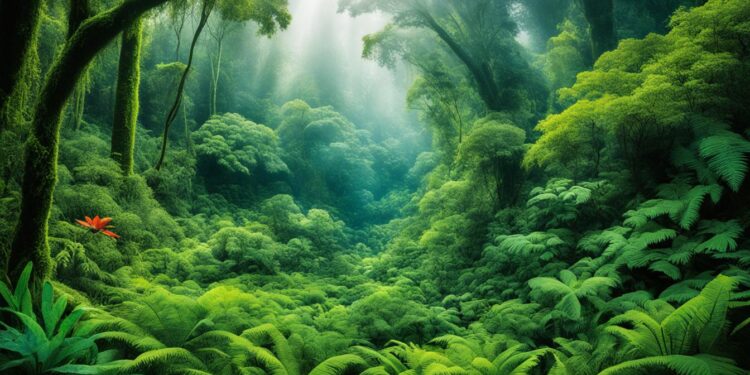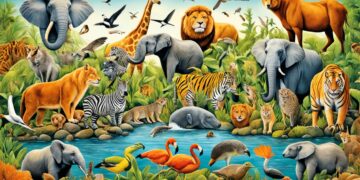Biodiversity is a wonder of our planet, a complex web of life. It’s the base of our ecosystems’ balance. From the trees that clean our air to the creatures that keep nature in check, it’s key to our thriving world.
Our planet is full of diverse life, each species adding to our environment’s health. This species diversity is not just beautiful. It’s crucial for the ecological balance that supports all life. Exploring nature shows us that biodiversity is vital for a sustainable future.
Preserving biodiversity helps protect our planet’s delicate environmental balance. By understanding how each species fits into the ecosystem, we can act to save this precious resource. This way, future generations can also enjoy the amazing diversity of life on Earth.
What is Biodiversity?
Biodiversity means the wide variety of life on Earth. It includes plants, animals, fungi, and tiny organisms. These living things and their connections in ecosystems make up biodiversity. Knowing what biodiversity is helps us see its key role in keeping our world balanced.
Understanding Biodiversity’s Definition
Biodiversity is all about the variety of life on Earth. It covers genetic diversity, species diversity, and ecosystem diversity. Genetic diversity is about the unique traits of each living thing. Species diversity looks at the many different kinds of plants and animals. Ecosystem diversity looks at how all these living things and their environments work together.
The Three Levels of Biodiversity
We can look at biodiversity in three ways: genetic diversity, species diversity, and ecosystem diversity. Genetic diversity is about the variety in genes within a species. This helps them adapt and survive in different places. Species diversity is the number of different kinds of plants and animals in a place. Ecosystem diversity is about the variety of ecosystems, like forests, oceans, and deserts, each with its own life and conditions.
Understanding these levels of biodiversity helps us see how complex and connected the natural world is. It shows us why it’s so important to protect the variety of life on our planet.
Biodiversity Hotspots Around the World
Biodiversity hotspots are key to saving our planet’s natural wonders. These areas are packed with unique and endangered species. They are crucial for conservation.
The Amazon rainforest is a famous hotspot in South America. It’s a lush, tropical area filled with diverse plants and animals. Many species call the Amazon home and can’t be found anywhere else. But, it faces threats like deforestation, making it urgent to protect it.
The Mediterranean Basin is another hotspot, covering parts of Europe, North Africa, and the Middle East. It’s known for its unique plants, with thousands of species found only here. Yet, it faces issues like urban growth, farming, and climate change.
Conservation is vital in these hotspots. It helps protect endangered species and keeps ecosystems balanced. We can help by supporting protected areas, promoting sustainable development, and eco-tourism. Everyone can play a part in saving these important places.
The Role of Biodiversity in Ecosystems
Biodiversity is like a rich tapestry of life on our planet. It’s key to keeping ecosystems in balance. This mix of species and their interactions is vital for services that keep our world going.
Maintaining the Balance of Nature
Every species, big or small, has a special role in nature. Losing this balance can lead to big problems. Diverse ecosystems can handle changes better, like climate change, keeping life on Earth going.
Ecosystem Services Provided by Biodiversity
Biodiversity supports many services important for humans. These include controlling the climate, cleaning water, helping grow food, and keeping nature beautiful for fun and inspiration. Losing species can harm these services, affecting the environment and people.

So, keeping nature in balance and the services biodiversity offers is crucial. As we work to protect nature, we must see how vital biodiversity is. It keeps the balance that supports all life on Earth.
Animal Diversity: A Treasure Trove of Species
The natural world is full of animal diversity, with millions of species everywhere. From tall giraffes in the African savanna to tiny hummingbirds in lush forests, our planet is amazing. This diversity shows the incredible variety of life on Earth.
Many ecosystems around the world are rich in species. The Amazon rainforest, for example, has colorful birds, monkeys, jaguars, and snakes. Coral reefs in the oceans are full of fish, crustaceans, and marine mammals, each important to their habitats.
But, this diversity is in danger. Threats like habitat loss, pollution, and climate change harm animals. As we take over their homes, many species could disappear forever.
We must value animal diversity and work to protect it. By saving their habitats and resources, we help ensure that future generations can enjoy the amazing variety of life on Earth.
Plant Diversity: The Green Lungs of the Planet
Our planet’s incredible plant diversity is often called the “green lungs of the planet.” Plants are key to keeping our ecosystems balanced. They are the base for the diverse life around us. From tall trees to colorful wildflowers, the variety of plant species is amazing.
The Importance of Plant Diversity
Plant diversity adds beauty to our natural landscapes. It’s also crucial for ecosystem health and biodiversity. Plants turn sunlight, water, and carbon dioxide into energy and nutrients for many other species. The more plant species, the stronger and more adaptable the ecosystem is.
Plant diversity also supports many ecosystem services important for humans. These services include clean air and water, controlling climate, and helping pollinators. Plants act as the “green lungs” of our planet, absorbing and storing carbon. This helps fight climate change and keeps our biosphere healthy.
Now, protecting plant diversity is more important than ever. By keeping the diverse plant life that supports our world, we help our ecosystems stay resilient and healthy. This way, we can protect our shared home for the future.
Threats to Biodiversity
We must work hard to save the amazing variety of life on Earth. Two big dangers are habitat loss and fragmentation, and overexploitation and poaching.
Habitat Loss and Fragmentation
Habitat destruction and fragmentation are big threats to biodiversity. As people grow and need more land, we take over nature’s homes. This includes deforestation, city growth, and farming, leaving many species fighting for small, isolated spaces.
Overexploitation and Poaching
Overusing and poaching animals is also a big problem. The high demand for things like ivory and exotic pets is pushing many species to near extinction. Things like overfishing, illegal hunting, and trading endangered animals are making things worse.
We need to act fast to protect our planet’s diversity. This means strong conservation efforts, sustainable development, and stopping the illegal wildlife trade. Our commitment to nature is key to saving its future.

Conservation Efforts and Strategies
Our planet faces big threats to its biodiversity. To fight these threats, conservation efforts and strategies are key. Protected areas like national parks and wildlife reserves are crucial. They help protect habitats and species.
Protected Areas and National Parks
Protected areas, including national parks, limit human activity to save biodiversity. These places are safe for many plants and animals. They let them live without the danger of humans taking over or harming them.
National parks are important for saving nature. They show the beauty and value of our natural world. These parks are full of different plants and animals. They also offer chances for research, learning, and getting people involved.
Other strategies like habitat restoration, species reintroduction, and community projects help too. By using these different methods, conservationists work hard to protect nature for the future.
Economic Benefits of Biodiversity
Biodiversity has a huge economic value that goes beyond just the worth of natural resources. It includes the ecosystem services that healthy, diverse ecosystems provide. These services are key for human well-being and sustainable development.
Diverse ecosystems offer many economic benefits. They help regulate the climate, purify water, pollinate crops, and control pests naturally. These services cut down costs and support industries like farming, forestry, and tourism.
Biodiversity also plays a big role in sustainable development. It ensures the availability of natural resources, which are vital for many industries and economies. By keeping ecosystems diverse, we protect these resources for the future. This helps with sustainable economic growth and development.
Understanding the economic value of biodiversity helps policymakers, businesses, and individuals make better choices. By considering the economic benefits of biodiversity, we can work towards a sustainable and prosperous future for everyone.
Biodiversity and Human Well-Being
The link between biodiversity and our well-being is deep and complex. Keeping our natural world diverse is key for the planet’s health and ours. It affects our life quality, nutrition, and health.
The Connection Between Biodiversity and Health
Biodiversity is vital for our health. It helps keep our air and water clean. The variety of plants and animals keeps life balanced.
Healthy, biodiverse places filter out pollutants and control diseases. This helps us stay well.
Also, nature’s genetic diversity is full of potential medicines. Many modern medicines come from plants and tiny organisms. Protecting nature means we keep finding new ways to fight diseases and heal.
But there’s more to the link between nature and health. Being in nature can make us feel better mentally. It lowers stress and boosts well-being.
So, saving biodiversity helps us live better lives. It supports efforts to develop in a way that’s good for people and the planet.
The Future of Biodiversity
The future of biodiversity looks promising yet uncertain. There’s a growing awareness worldwide and a new focus on sustainable development. This approach aims to balance economic growth with protecting the environment. It gives us hope for a future where humans and nature can live together.
Sustainable Development and Biodiversity
Sustainable development is key to protecting life on Earth. By using eco-friendly practices, cutting down on carbon emissions, and fixing damaged habitats, we can make ecosystems stronger. This helps keep a wide variety of plants and animals alive. We need to invest in renewable energy, sustainable farming, and smart use of resources.
But, we face big challenges. Threats like losing habitats, climate change, and invasive species are still a danger to biodiversity. To beat these challenges, we need a global effort. Governments, businesses, and people must all work together for change. With teamwork and a sense of responsibility, we can protect the Earth’s natural beauty for the future.







